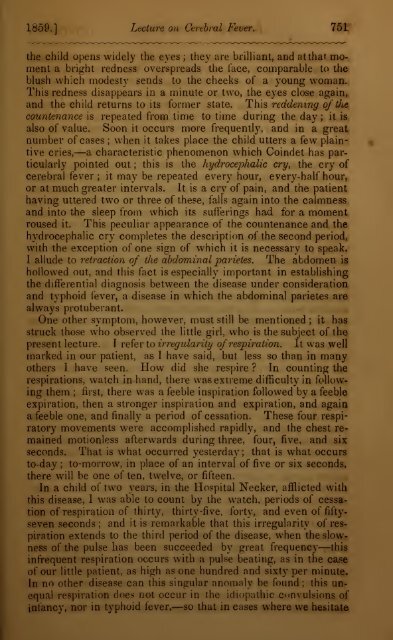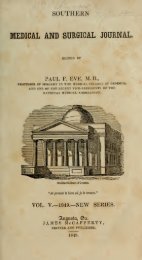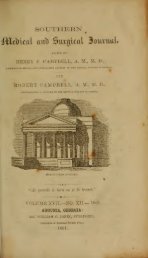750 Lecture on Cerebral Fever. [November,same hour, in other cases, but more rarely, the fever is continued,but moderate, with frequent remission. The febrile movement,the violent headache, more or less limited to one part of the cranium,the moroseness of the patient, its sleeplessness, the persistentvomiting, are signs of capital importance. When the physicianobserves them, he should be carefully upon his guard. It isnot rare, even at this stage of the disease, to be able to discovermore serious symptoms, amblyopia, hemiopia, etc.Such are the symptoms o( the first period of cerebral fever.In the seeond period, to the sleeplessness, the febrile movement,<strong>and</strong> the violent headache, succeed a deceitful calm <strong>and</strong> repose,which is likely to tranquilize the uninformed physician, <strong>and</strong> aboveall to quiet the apprehensions of the parents, who are alwaysready to seize upon any favorable indications. But the practitionerwho has been taught by experience, informed by the symptomsof the preceding period which he has seen or been told,knows too surely that cerebral fever is established, that it hasentered upon its apyretic stage, <strong>and</strong> that henceforward it will steadilypursue its fatal course. The pulse now shows a peculiarity ;ordinarily regular in the first days of invasion, (I say ordinarily,for sometimes in the first period there is irregularity which givesvaluable information to the physician,) it becomes now, in thesecond period, remarkably slow, at the same time unequal, but,above all, excessively irregular; while normally, in a child fouror five years old, there are between ninety <strong>and</strong> a hundred beatsper minute, <strong>and</strong> in an infant at the breast, from one hundred toone hundred <strong>and</strong> twenty, in the second period of cerebral feverthe number of pulsations falls to sixty, sometimes fifty-five, orfifty ; <strong>and</strong> it may fall even below that, while at the same time, itpresents great inequality <strong>and</strong> irregularity.At this time the child remains in a state of somnolence whichcontrasts singularly with the agitation of the first period. It enjoys,in appearance, a peaceful slumber, which rejoices <strong>and</strong> comfortsthe friends who surround it ; but soon, seeing it prolonged,they become justly troubled <strong>and</strong> alarmed. This somnolence persistsfrom four to five days. If the little sufferer is awakened, itutters a cry of impatience, <strong>and</strong> immediately drops asleep again ;yesterday terrified at vour presence, afraid of the physician whoseexamination harrassed it, it no longer exhibits any alarm ; thenit could not endure even an examination of the pulse, the slightesttouch agitated <strong>and</strong> tormented it,—now it appears indifferentto anything you may do ;you open its eyes, you pinch it to discoverthe degree of cutaneons sensibility, <strong>and</strong> if it appears for amoment irritated, it drops immediately into its quiet slumber.This is a symptom of most serious character, <strong>and</strong> which we findin scarcely any other disease. About the end of two days, thecountenance presents a strange appearance. From time to time
1859.] Lecture on Cerebral Fever. 751the child opens widely the eyes ; they are brilliant, <strong>and</strong> at that momenta bright redness overspreads the face, comparable to theblush which modesty sends to the cheeks of a young woman.This redness disappears in a minute or two, the eyes close again,<strong>and</strong> the child returns to its former state. This reddening of tliecountenance is repeated from time to time during the day ; it isalso of value. Soon it occurs more frequently, <strong>and</strong> in a greatnumber of cases; when it takes place the child utters a few plaintivecries,—a characteristic phenomenon which Coindet has particularlypointed out ; this is the hydrocephalic cry, the cry ofcerebral fever ; it may be repeated every hour, every-half hour,or at much greater intervals. It is a cry of pain, <strong>and</strong> the patienthaving uttered two or three of these, falls again into the calmness<strong>and</strong> into the sleep from which its sufferings had for a momentroused it. This peculiar appearance of the countenance <strong>and</strong> thehydrocephalic cry completes the description of the second period,with the exception of one sign of which it is necessary to speak.I allude to retraction of the abdominal parietes. The abdomen ishollowed out, <strong>and</strong> this fact is especially important in establishingthe differential diagnosis between the disease under consideration<strong>and</strong> typhoid lever, a disease in which the abdominal parietes arealways protuberant.One other symptom, however, must still be mentioned ; it hasstruck those who observed the little girl, who is the subject of thepresent lecture. I refer to irregularity of respiration. It was wellmarked in our patient, as I have said, but less so than in manyothers I have seen. How did she respire ? In counting therespirations, watch in h<strong>and</strong>, there was extreme difficulty in followingthem ; first, there was a feeble inspiration followed by a feebleexpiration, then a stronger inspiration <strong>and</strong> expiration, <strong>and</strong> againa feeble one, <strong>and</strong> finally a period of cessation. These four respiratorymovements were accomplished rapidly, <strong>and</strong> the chest remainedmotionless afterwards during three, four, five, <strong>and</strong> sixseconds. That is what occurred yesterday; that is what occurstoday ; to-morrow, in place of an interval of five or six seconds,there will be one of ten, twelve, or fifteen.In a child of two years, in the Hospital Necker, afflicted withthis disease, I was able to count by the watch, periods of cessationof respiration of thirty, thirty-five, forty, <strong>and</strong> even of fiftysevenseconds; <strong>and</strong> it is remarkable that this irregularity of respirationextends to the third period of the disease, when the slownessof the pulse has been succeeded by great frequency—thisinfrequent respiration occurs with a pulse beating, as in the caseof our little patient, as high as one hundred <strong>and</strong> sixty per minute.In no other disease can this singular anomaly be found ; this unequalrespiration does not occur in the idiopathic convulsions ofinfancy, nor in typhoid fever,—so that in cases where we hesitate
- Page 1 and 2: SOUTHERNMEDICAL AND SUBGICAL JOURNA
- Page 3 and 4: 1859.] Climate to the Consumptive,
- Page 5 and 6: 1859.] Climate to the Consumptive,
- Page 7 and 8: Aug.Oct.1859.] Climate to the Consu
- Page 9 and 10: 1859.] Climate to the Consumptive,
- Page 11 and 12: 1859.] Climate to the Consumptive,
- Page 13 and 14: 1S59.] Climate to tJte Consumptive,
- Page 15 and 16: 1859.] Climate to l/ie Consumptive,
- Page 17 and 18: 1859.] Climate to the Consumptive,
- Page 19 and 20: 1859.] Climate to the Consumptive,
- Page 21 and 22: 1859.] Dugas, on Fracture of Hie Sc
- Page 23 and 24: 1869.] Lecture upon Cerebral Fever.
- Page 25 and 26: • of1859.] Lecture on Cerebral Fe
- Page 27: 1859.] Lecture on Cerebral Fever. 7
- Page 31 and 32: 1859.] Lecture on Gerebral J' 753un
- Page 33 and 34: 1859.] Lecture on Cerebral Ftthey a
- Page 35 and 36: :1859.] Attempted Abortion and Deat
- Page 37 and 38: 1859.] Attempted Abortion and Death
- Page 39 and 40: :—:1859.] Diphtheria. 761by its o
- Page 41 and 42: —:1859.] Diphtheria. 763ride of i
- Page 43 and 44: ——1859.] Diarrhoea of Infants a
- Page 45 and 46: 1859.] Action of Mercury on the Sec
- Page 47 and 48: 1859.] Defective Assimilation in In
- Page 49 and 50: —1859.] Cancerous Ulceration clos
- Page 51 and 52: —1859.] Vegetation of the Genital
- Page 53 and 54: 1859.] Gases of Suppression of the
- Page 55 and 56: 1859.] Cases of Suppression of the
- Page 57 and 58: ——;1859.] After-treatment of th
- Page 59 and 60: 1859.] Dr. 0. C. Gibbs. Summary. 78
- Page 61 and 62: 1859.] Dr. 0. C. GrBBS. Summary, 78
- Page 63 and 64: :;1859.] Secale Cornulam for t?ie E
- Page 65 and 66: 1859.] Divisions for the Cure of De
- Page 67 and 68: ;1859.] Incision in Anthrax. 789Inc
- Page 69 and 70: :;1859.] Editorial and Miscellaneou
- Page 71 and 72: ———and1859.] Miscellaneous. 7








